A Pathway for the German Energy Sector Compatible with a 1.5 °C Carbon Budget
Abstract
:1. Introduction
2. Materials and Methods
2.1. Target and Storyline: Assessing the Limits of a Carbon Budget for the Energy System
2.2. Definition of a Carbon Budget for the German Energy Sector
2.3. Modeling Approach: Energy System Modeling, Cost Optimization and Model Coupling
2.3.1. Energy System Model (ESM)
2.3.2. REMix
2.4. System Boundary
2.5. Model Coupling
2.6. Technology Data
- Technical lifetime.
- Specific investment costs.
- Specific fixed operation and maintenance costs.
- Specific variable operating and maintenance costs.
- Efficiency.
| Specific Investment Costs | Lifetime | Specific Fixed Operation and Maintenance Cost | Efficiency | ||
|---|---|---|---|---|---|
| Renewable Power Technology | Scenario Year | EUR2016/kW | Years | EUR2016/kW | % |
| Run of river * | 2020–2050 | 4273 | 60 | 214 | 100 |
| Photovoltaic * | 2020 | 900 | 25 | 15 | 100 |
| 2030 | 700 | 30 | 12 | ||
| 2040 | 600 | 30 | 10 | ||
| 2050 | 540 | 30 | 9 | ||
| Offshore wind * | 2020 | 3500 | 20 | 110 | 100 |
| 2030 | 2250 | 25 | 90 | ||
| 2040 | 2100 | 30 | 85 | ||
| 2050 | 2100 | 30 | 75 | ||
| Onshore wind * | 2020 | 1310 | 20 | 45 | 100 |
| 2030 | 1250 | 22 | 45 | ||
| 2040 | 1180 | 25 | 40 | ||
| 2050 | 1100 | 25 | 38 | ||
| Gas converting technology | |||||
| Electrolyzer [34] | 2020 | 900 | 25 | 18 | 69 |
| 2030 | 550 | 11 | 74 | ||
| 2040 | 450 | 9 | 77 | ||
| 2050 | 350 | 7 | 80 | ||
| Methanation [35] | 2020 | 1500 | 25 | 37.5 | 75 |
| 2030 | 1000 | 25 | 80 | ||
| 2040 | 900 | 22.5 | 85 | ||
| 2050 | 800 | 20 | 90 | ||
| Storage technology | EUR2016/kWh | years | EUR2016/kWh | % | |
| Lithium-ion battery (storage) [36,37] | 2020 | 300 | 21 | 2.7 | 93 |
| 2030 | 225 | 22 | 1.8 | 94 | |
| 2040 | 188 | 23 | 1.1 | 95 | |
| 2050 | 150 | 25 | 0.8 | 97 | |
3. Scenario Assumptions for the Budget Scenario (BS)
3.1. Socio Economic Frame
3.2. Demand Assumptions by Sector
3.2.1. Residential and Services and Other Sectors
3.2.2. Industry
3.2.3. Transport
3.3. Technological Limitations and Targets for Energy Supply in 2050
- Individual transport is mostly based on hybrid electric vehicles (EREV: 48%), battery electric vehicles (BEV: 39%) and fuel cell vehicles (FCV: 12%).
- Light duty traffic has similar shares with EREV (32%), BEV (52%) and FCV (16%).
- Heavy duty traffic features a higher share of FCV (20%) and a focus on catenary electric and hybrid trucks (78%) with significant residual fuel demand.
- Rail is assumed to be completely electric in 2050.
- The residual fuel demand, e.g., for hybrid vehicles, navigation and aviation is assumed to come from synfuels (72%) and biofuels (28%).
4. Scenario Results: How Fast Do We Have to Change the Energy Sector?
4.1. CO2 Emissions from the Energy System
4.2. Energy Demand
4.2.1. Heat Supply
4.2.2. Transport Sector
4.3. Power Supply—Results of the REMix Modelling
Sensitivity Analysis of the Power Supply
4.4. Primary Energy Supply
5. Discussion
6. Conclusions and Outlook
Supplementary Materials
Author Contributions
Funding
Institutional Review Board Statement
Informed Consent Statement
Data Availability Statement
Acknowledgments
Conflicts of Interest
References
- UNEP. Emissions Gap Report 2019. Executive Summary; United Nations Environment Programme: Nairobi, Kenya, 2019; Available online: https://www.unep.org/resources/emissions-gap-report-2019 (accessed on 19 August 2021).
- IPCC. Summary for Policymakers. In Global Warming of 1.5°C. An IPCC Special Report on the Impacts of Global Warming of 1.5°C above Pre-Industrial Levels and Related Global Greenhouse Gas Emission Pathways, in the Context of Strengthening the Global Response to the Threat of Climate Change, Sustainable Development, and Efforts to Eradicate Poverty; Masson-Delmotte, V., Zhai, P., Pörtner, H.-O., Roberts, D., Skea, J., Shukla, P.R., Pirani, A., Moufouma-Okia, W., Péan, C., Pidcock, R., et al., Eds.; World Meteorological Organization: Geneva, Switzerland, 2018; p. 32. [Google Scholar]
- Friedlingstein, P.; O’Sullivan, M.; Jones, M.W.; Andrew, R.M.; Hauck, J.; Olsen, A.; Peters, G.P.; Peters, W.; Pongratz, J.; Sitch, S.; et al. Global Carbon Budget 2020. Earth Syst. Sci. Data 2020, 12, 3269–3340. [Google Scholar] [CrossRef]
- Gignac, R.; Matthews, H.D. Allocating a 2 °C cumulative carbon budget to countries. Environ. Res. Lett. 2015, 10, 075004. [Google Scholar] [CrossRef] [Green Version]
- Rogelj, J.; Geden, O.; Cowie, A.; Reisinger, A. Net-zero emissions targets are vague: Three ways to fix. Nat. Commun. 2021, 591, 365–368. [Google Scholar] [CrossRef] [PubMed]
- UNEP. Emissions Gap Report 2020. Executive Summary; United Nations Environment Programme: Nairobi, Kenya, 2020; Available online: https://www.unep.org/emissions-gap-report-2020 (accessed on 19 August 2021).
- UNFCCC. GHG Data Interface, Report Produced on November, 11th 2021. Available online: https://di.unfccc.int/detailed_data_by_party (accessed on 11 November 2021).
- EU-Commission. The European Green Deal. 2019. Available online: https://eur-lex.europa.eu/resource.html?uri=cellar:b828d165-1c22-11ea-8c1f-01aa75ed71a1.0002.02/DOC_1&format=PDF (accessed on 11 January 2021).
- McGrath, M. Climate Change: China Aims for ’Carbon Neutrality by 2060’. Available online: https://www.bbc.com/news/science-environment-54256826 (accessed on 26 April 2021).
- Naegler, T.; Sutardhio, C.; Weidlich, A.; Pregger, T. Exploring long-term strategies for the German Energy Transition - A Review of Multi-Sector Energy Scenarios. Renew. Sustain. Energy Transit. 2021, 100010. [Google Scholar] [CrossRef]
- Van Vuuren, D.P.; van Soest, H.; Riahi, K.; Clarke, L.; Krey, V.; Kriegler, E.; Rogelj, J.; Schaeffer, M.; Tavoni, M. Carbon budgets and energy transition pathways. Environ. Res. Lett. 2016, 11, 075002. [Google Scholar] [CrossRef] [Green Version]
- Kobiela, G.; Samadi, S.; Kurwan, J.; Tönjes, A.; Fischedick, M.; Koska, T.; Lechtenböhmer, S.; März, S.; Schüwer, D. CO2-Neutral bis 2035: Eckpunkte Eines Deutschen Beitrags zur Einhaltung der 1, 5-°C-Grenze; Wuppertal Institut: Wuppertal, Germany, 2020; Available online: https://epub.wupperinst.org/frontdoor/deliver/index/docId/7606/file/7606_CO2-neutral_2035.pdf (accessed on 21 April 2021).
- Robinson, J.B. Energy backcasting A proposed method of policy analysis. Energy Policy 1982, 10, 337–344. [Google Scholar] [CrossRef]
- Mengis, N.; Simon, S.; Thoni, T.; Stevenson, A.; Goerl, K.; Steuri, B.; Oschlies, A. Defining the German Carbon Budget; Helmholtz Climate Initiative: Berlin, Germany, 2021; Available online: https://www.netto-null.org/Projektergebnisse/Project_Briefings/index.php.de (accessed on 20 October 2021).
- Meyer, A. Contraction and Convergence: The Global Solution to Climate Change Devon; Green Books: Cambridge, UK, 2000. [Google Scholar]
- Stott, R. Contraction and convergence: The best possible solution to the twin problems of climate change and inequity. BMJ 2012, 344, e1765. [Google Scholar] [CrossRef] [Green Version]
- Meyer, A. C&C Example (28 June 2010) in Wikipedia. Available online: https://commons.wikimedia.org/wiki/File:Web_C%26C.png (accessed on 17 October 2021).
- AGEB. Auswertungstabellen zur Energiebilanz Deutschland 1990–2016. Arbeitsgemeinschaft Energiebilanzen. Available online: https://www.ag-energiebilanzen.de/10-0-Auswertungstabellen.html (accessed on 29 May 2021).
- AGEB. Energiebilanz der Bundesrepublik Deutschland 2019. Arbeitsgemeinschaft Energiebilanzen. Available online: https://ag-energiebilanzen.de/7-0-Bilanzen-1990-2019.html (accessed on 27 April 2021).
- BMWi. Zahlen und Fakten. Energiedaten. Gesamtausgabe - Datensammlung des BMWi. Bundesministerium für Wirtschaft und Energie. Available online: https://www.bmwi.de/Redaktion/DE/Artikel/Energie/energiedaten-gesamtausgabe.html (accessed on 27 April 2021).
- AGEB. Satellitenbilanz "Erneuerbare Energieträger" zur Energiebilanz der Bundesrepublik Deutschland 2019. Available online: https://ag-energiebilanzen.de/7-0-Bilanzen-1990-2019.html (accessed on 27 April 2021).
- Simon, S.; Naegler, T.; Gils, H. Transformation towards a Renewable Energy System in Brazil and Mexico—Technological and Structural Options for Latin America. Energies 2018, 11, 907. [Google Scholar] [CrossRef] [Green Version]
- Teske, S.; Pregger, T.; Simon, S.; Naegler, T.; Pagenkopf, J.; van den Adel, B.; Meinshausen, M.; Dooley, K.; Briggs, C.; Dominish, E.; et al. Methodology. In Achieving the Paris Climate Agreement Goals: Global and Regional 100% Renewable Energy Scenarios with Non-Energy GHG Pathways for +1.5 °C and +2 °C; Teske, S., Ed.; Springer International Publishing: Cham, Switzerland, 2019; pp. 25–78. [Google Scholar]
- Gils, H.; Simon, S.; Soria, R. 100% Renewable Energy Supply for Brazil—The Role of Sector Coupling and Regional Development. Energies 2017, 10, 1859. [Google Scholar] [CrossRef] [Green Version]
- Scholz, Y. Renewable Energy Based Electricity Supply at Low Costs: Development of the REMix Model and Application for Europe; Universitätsbibliothek der Universität Stuttgart: Stuttgart, Germany, 2012; Available online: http://elib.uni-stuttgart.de/opus/volltexte/2012/7635 (accessed on 30 September 2021).
- Gils, H.C.; Scholz, Y.; Pregger, T.; Luca de Tena, D.; Heide, D. Integrated modelling of variable renewable energy-based power supply in Europe. Energy 2017, 123, 173–188. [Google Scholar] [CrossRef] [Green Version]
- Xiao, M.; Wetzel, M.; Pregger, T.; Simon, S.; Scholz, Y. Modeling the Supply of Renewable Electricity to Metropolitan Regions in China. Energies 2020, 13, 3042. [Google Scholar] [CrossRef]
- Gils, H.C.; Simon, S. Carbon neutral archipelago—100% renewable energy supply for the Canary Islands. Appl. Energy 2017, 188, 342–355. [Google Scholar] [CrossRef] [Green Version]
- Nitsch, J.; Pregger, T.; Naegler, T.; Heide, D.; Tena, D.L.d.; Trieb, F.; Scholz, Y.; Nienhaus, K.; Gerhardt, N.; Sterner, M.; et al. Langfristszenarien und Strategien für den Ausbau der Erneuerbaren Energien in Deutschland bei Berücksichtigung der Entwicklung in Europa und Global; Deutsches Zentrum für Luft- und Raumfahrt, Fraunhofer: Stuttgart, Germany; Institut für Windenergie und Energiesystemtechnik (IWES): Kassel, Germany; Ingenieurbüro für neue Energien (IFNE): Teltow, Germany, 2012; Available online: http://www.fvee.de/fileadmin/publikationen/Politische_Papiere_anderer/12.03.29.BMU_Leitstudie2011/BMU_Leitstudie2011.pdf (accessed on 13 March 2013).
- Steurer, M.; Brand, H.; Blesl, M.; Borggrefe, F.; Fahl, U.; Fuchs, A.-L.; Gils, H.C.; Hufendiek, K.; Münkel, A.; Rosenberg, M.; et al. Energiesystemanalyse Baden-Württemberg: Datenanhang zu Techoökonomischen Kenndaten; Ministerium für Umwelt Klima und Energiewirtschaft Baden-Württemberg: Stuttgart, Germany; STrise—Universität Stuttgart, Deutsches Zentrum für Luft- und Raumfahrt, Zentrum für Sonnenenergie- und Wasserstoff-Forschung Baden-Württemberg: Stuttgart, Germany, 2018. [Google Scholar]
- Tsiropoulos, I.; Tarvydas, D.; Zucker, A. Cost Development of Low Carbon Energy Technologies-Scenario-Based Cost Trajectories to 2050, 2017 ed.; Publications Office of the European Union: Luxembourg, 2018; Available online: https://publications.jrc.ec.europa.eu/repository/handle/JRC109894 (accessed on 14 October 2021).
- Cao, K.-K.; Pregger, T.; Scholz, Y.; Gils, H.C.; Nienhaus, K.; Deissenroth, M.; Schimeczek, C.; Krämer, N.; Schober, B.; Hendrik, L. Analyse von Strukturoptionen zur Integration erneuerbarer Energien in Deutschland und Europa unter Berücksichtigung der Versorgungssicherheit (INTEEVER); Bundesministerium für Wirtschaft und Energie: Berlin, Germany, 2019. [Google Scholar]
- REMix Model Input Data for the THG95/GHG95 Scenario Analysed within the MuSeKo Project. Available online: https://doi.org/10.5281/zenodo.5705414 (accessed on 30 November 2021).
- DEA. Technology Data Renewable Fuels; Danish Energy Agency and Energinet: Copenhagen, Denmark, 2021. Available online: https://ens.dk/sites/ens.dk/files/Analyser/technology_data_for_renewable_fuels.pdf (accessed on 8 September 2021).
- Fette, M.; Brandstätt, C.; Gils, H.C.; Gardian, H.; Pregger, T.; Schaffert, J.; Tali, E.; Brücken, N. Multi-Sektor-Kopplung-Modellbasierte Analyse der Integration erneuerbarer Stromerzeugung durch die Kopplung der Stromversorgung mit dem Wärme-, Gas-und Verkehrssektor; Fraunhofer-Institut für Fertigungstechnik und Angewandte Materialforschung (IFAM): Bremen, Germany; Deutsches Zentrum für Luft- und Raumfahrt e.V. (DLR): Köln, Germany; Gas- und Wärme-Institut Essen e.V.: Essen, Germany, 2020; Available online: https://elib.dlr.de/135971/ (accessed on 20 October 2020).
- VDE. Energiespeicher für die Energiewende—Speicherungsbedarf und Auswirkungen auf das Übertragungsnetz für Szenarien bis 2050; Verband der Elektrotechnik, Elektronik, Informationstechnik e.V.: Frankfurt, Germany, 2012. [Google Scholar]
- Sauer, D.; Fuchs, G.; Lunz, B.; Leuthold, M. Technology Overview on Electricity Storage—Overview on the Potential and on the Deployment Perspectives of Electricity Storage Technologies; ISEA/RWTH Aachen University: Aachen, Germany, 2012. [Google Scholar]
- BMWi. Entwurf des Integrierten Nationalen Energie- und Klimaplans; Bundesministerium für Wirtschaft und Energie. 2019. Available online: https://www.bmwi.de/Redaktion/DE/Downloads/E/entwurf-des-integrierten-nationalen-energie-und-klimaplans.pdf?__blob=publicationFile&v=12 (accessed on 4 March 2020).
- Kemmler, A.; Kirchner, A.; Auf der Maur, A.; Ess, F.; Kreidelmeyer, S.; Piégsa, A.; Spillmann, T.; Wünsch, M.; Ziegenhagen, I. Energiewirtschaftliche Projektionen und Folgeabschätzungen 2030/2050, Dokumentation von Referenzszenario und Szenario mit Klimaschutzprogramm 2030; Prognos AG, Fraunhofer ISI, GWS: Basel, Schweizerland, 2020. [Google Scholar]
- Thrän, D.; Lauer, M.; Dotzauer, M.; Kalcher, J.; Oehmichen, K.; Majer, S.; Millinger, M.; Jordan, M. Technoökonomische Analyse und Transformationspfade des energetischen Biomassepotentials (TATBIO); DBFZ Deutsches Biomasseforschungszentrum, UFZ Helmholtz-Zentrum für Umweltforschung: Leipzig, Germany, 2019; Available online: https://www.bmwi.de/Redaktion/DE/Publikationen/Studien/technooekonomische-analyse-und-transformationspfade-des-energetischen-biomassepotentials.html (accessed on 21 October 2021).
- FNR. Basisdaten Bioenergie Deutschland; Fachagentur Nachwachsende Rohstoffe: Gülzow, Germany, 2018. [Google Scholar]
- Liebich, A.; Fröhlich, T.; Münter, D.; Fehrenbach, H.; Giegrich, J.; Köppen, S.; Dünnebeil, F.; Knörr, W.; Biemann, K.; Simon, S.; et al. System Comparison of Storable Energy Carriers from Renewable Energies; IFEU—Institut für Energie- und Umweltforschung: Heidelberg, Germany; Deutsches Zentrum für Luft- und Raumfahrt, Joanneum: Stuttgart, Germany; Research Forschungsgesellschaft mbH: Graz, Austria, 2021. [Google Scholar]
- Bataille, C.; Åhman, M.; Neuhoff, K.; Nilsson, L.J.; Fischedick, M.; Lechtenböhmer, S.; Solano-Rodriquez, B.; Denis-Ryan, A.; Stiebert, S.; Waisman, H.; et al. A review of technology and policy deep decarbonization pathway options for making energy-intensive industry production consistent with the Paris Agreement. J. Clean. Prod. 2018, 187, 960–973. [Google Scholar] [CrossRef] [Green Version]
- Davis, S.J.; Lewis, N.S.; Shaner, M.; Aggarwal, S.; Arent, D.; Azevedo, I.L.; Benson, S.M.; Bradley, T.; Brouwer, J.; Chiang, Y.M.; et al. Net-zero emissions energy systems. Science 2018, 360. [Google Scholar] [CrossRef] [Green Version]
- Naegler, T.; Simon, S.; Klein, M.; Gils, H.C. Quantification of the European industrial heat demand by branch and temperature level. Int. J. Energy Res. 2015, 39, 2019–2030. [Google Scholar] [CrossRef] [Green Version]
- Rehfeldt, M.; Fleiter, T.; Toro, F. A bottom-up estimation of the heating and cooling demand in European industry. Energy Effic. 2017, 11, 1057–1082. [Google Scholar] [CrossRef]
- Harpprecht, C.; Naegler, T.; Steubing, B.; Tukker, A.; Simon, S. Decarbonization scenarios for the iron and steel sector: Germany as a case study. In preparation.
- Bhaskar, A.; Assadi, M.; Nikpey Somehsaraei, H. Decarbonization of the Iron and Steel Industry with Direct Reduction of Iron Ore with Green Hydrogen. Energies 2020, 13, 758. [Google Scholar] [CrossRef] [Green Version]
- Fischedick, M.; Marzinkowski, J.; Winzer, P.; Weigel, M. Techno-economic evaluation of innovative steel production technologies. J. Clean. Prod. 2014, 84, 563–580. [Google Scholar] [CrossRef] [Green Version]
- Roderer, V. Future Environmental Impacts of Cement Production in Germany and the Effects on Downstream Consumers; Pforzheim University: Pforzheim, Germany, 2021; Available online: https://elib.dlr.de/143385/1/Masterarbeit_Roderer_original.pdf (accessed on 11 August 2021).
- Brunke, J.-C.; Blesl, M. Energy conservation measures for the German cement industry and their ability to compensate for rising energy-related production costs. J. Clean. Prod. 2014, 82, 94–111. [Google Scholar] [CrossRef]
- Ehrenberger, S.; Seum, S.; Pregger, T.; Simon, S.; Knitschky, G.; Kugler, U. Land transport development in three integrated scenarios for Germany – Technology options, energy demand and emissions. Transp. Res. D Transp. Environ. 2021, 90, 102669. [Google Scholar] [CrossRef]
- Henning, A.; Plohr, M.; Özdemir, D.; Hepting, M.; Keimel, H.; Sanok, S.; Sausen, R.; Pregger, T.; Seum, S.; Heinrichs, M. The DLR Transport and the Environment Project-Building Competency for a Sustainable Mobility Future; DLR Deutsches Zentrum fur Luft- und Raumfahrt e.V.: Köln, Germany, 2016; pp. 192–198. [Google Scholar]
- Hepting, M.; Pak, H.; Grimme, W.; Dahlmann, K.; Jung, M. Climate impact of German air traffic: A scenario approach. Transp. Res. D Transp. Environ. 2020, 85, 102467. [Google Scholar] [CrossRef]
- Brosowski, A.; Thrän, D.; Mantau, U.; Mahro, B.; Erdmann, G.; Adler, P.; Stinner, W.; Reinhold, G.; Hering, T.; Blanke, C. A review of biomass potential and current utilisation – Status quo for 93 biogenic wastes and residues in Germany. Biomass Bioenergy 2016, 95, 257–272. [Google Scholar] [CrossRef] [Green Version]
- FNR. Anbau und Verwendung nachwachsender Rohstoffe in Deutschland; Fachagentur Nachwachsende Rohstoffe e.V.: Gülzow, Germany, 2021; Available online: https://www.fnr-server.de/ftp/pdf/berichte/22004416.pdf (accessed on 3 June 2021).
- FNR. Zeitreihe für den Anbau nachwachsender Rohstoffe in Deutschland; Fachagentur Nachwachsende Rohstoffe e.V.: Gülzow, Germany, 2017. [Google Scholar]
- Von Krbek, K.; Bertsch, V.; Scholz, Y. Can resource classes substitute spatial resolution in energy system models? A spatial scaling analysis. In Proceedings of the European Conference on Operational Research, Athens, Greece, 11–14 July 2021. [Google Scholar]
- Sterchele, P.; Brandes, J.; Heilig, J.; Wrede, D.; Kost, C.; Schlegl, T.; Bett, A.; Henning, H.-M. Wege zu einem klimaneutralen Energiesystem: Die deutsche Energiewende im Kontext gesellschaftlicher Verhaltensweisen; Fraunhofer-Institut für Solare Energiesysteme ISE: Freiburg, Germany, 2020; Available online: https://www.ise.fraunhofer.de/de/veroeffentlichungen/studien/wege-zu-einem-klimaneutralen-energiesystem.html (accessed on 12 October 2021).
- IHA. In 2020 Hydropower Status Report Sector Trends and Insights; International Hydropower Association: London, UK, 2020; Available online: https://hydropower-assets.s3.eu-west-2.amazonaws.com/publications-docs/2020_hydropower_status_report.pdf (accessed on 3 June 2021).
- Gesetz zur Änderung des Windenergie-auf-See-Gesetzes und anderer Vorschriften. Available online: https://www.bgbl.de/xaver/bgbl/start.xav?startbk=Bundesanzeiger_BGBl&start=//*%5b@attr_id=%27bgbl120s2682.pdf%27%5d#__bgbl__%2F%2F*%5B%40attr_id%3D%27bgbl120s2682.pdf%27%5D__1631697779438 (accessed on 17 September 2021).
- Gils, H.C.; Gardian, H.; Schmugge, J. Interaction of hydrogen infrastructures with other sector coupling options towards a zero-emission energy system in Germany. Renew. Energy 2021, 180, 140–156. [Google Scholar] [CrossRef]
- Junne, T.; Simon, S.; Buchgeister, J.; Saiger, M.; Baumann, M.; Haase, M.; Wulf, C.; Naegler, T. Environmental Sustainability Assessment of Multi-Sectoral Energy Transformation Pathways: Methodological Approach and Case Study for Germany. Sustainability 2020, 12, 8225. [Google Scholar] [CrossRef]
- Madeddu, S.; Ueckerdt, F.; Pehl, M.; Peterseim, J.; Lord, M.; Kumar, K.A.; Krüger, C.; Luderer, G. The CO2 reduction potential for the European industry via direct electrification of heat supply (power-to-heat). Environ. Res. Lett. 2020, 15. [Google Scholar] [CrossRef]
- Fraunhofer-Institut für System- und Innovationsforschung ISI; Consentec GmbH; Sensfuß, F.; Lux, B.; Bernath, C.; Kiefer, C.; Pfluger, B.; Kleinschmitt, C.; Franke, K.; Deac, G.; et al. Langfristszenarien für die Transformation des Energiesystems in Deutschland. Available online: https://www.langfristszenarien.de/enertile-explorer-wAssets/docs/LFS_Kurzbericht_final_v5.pdf (accessed on 15 November 2021).
- ENTSO-E. Netzentwicklungsplan 2030; European Association for the Cooperation of Transmission System Operators (TSOs) for Electricity: Brussels, Belgium, 2016. [Google Scholar]
- Sasanpour, S.; Cao, K.-K.; Gils, H.C.; Jochem, P. Strategic policy targets and the contribution of hydrogen in a 100% renewable European power system. Energy Rep. 2021, 7, 4595–4608. [Google Scholar] [CrossRef]
- Zappa, W.; Junginger, M.; van den Broek, M. Is a 100% renewable European power system feasible by 2050? Appl. Energy 2019, 233–234, 1027–1050. [Google Scholar] [CrossRef]
- Child, M.; Kemfert, C.; Bogdanov, D.; Breyer, C. Flexible electricity generation, grid exchange and storage for the transition to a 100% renewable energy system in Europe. Renew. Energy 2019, 139, 80–101. [Google Scholar] [CrossRef]
- Fasihi, M.; Bogdanov, D.; Breyer, C. Long-Term Hydrocarbon Trade Options for the Maghreb Region and Europe—Renewable Energy Based Synthetic Fuels for a Net Zero Emissions World. Sustainability 2017, 9, 306. [Google Scholar] [CrossRef] [Green Version]
- Lu, Y.; Khan, Z.A.; Alvarez-Alvarado, M.S.; Zhang, Y.; Huang, Z.; Imran, M. A Critical Review of Sustainable Energy Policies for the Promotion of Renewable Energy Sources. Sustainability 2020, 12, 5078. [Google Scholar] [CrossRef]
- IWR-Online. Klimafreundlicher Stahl – Salzgitter AG erhält BMU-Förderung. Available online: https://www.iwr.de/news/klimafreundlicher-stahl-salzgitter-ag-erhaelt-bmu-foerderung-news37124 (accessed on 30 September 2021).
- Rhoden, I.; Simon, S.; Ball, C.; Mengis, N.; Voegele, S.; Baetcke, L.; Steuri, B.; Kuckshinrichs, W.; Manske, D.; Yeates, C. Spatial Heterogeneity-Challenge and opportunity for net-zero Germany; Systemforschung und Technologische Entwicklung, Forschungszentrum Jülich: Jülich, Germany, 2021. [Google Scholar]
- Nasr, A.K.; Kashan, M.K.; Maleki, A.; Jafari, N.; Hashemi, H. Assessment of Barriers to Renewable Energy Development Using Stakeholders Approach. Entrep. Sustain. Issues 2020, 7, 2526–2541. [Google Scholar] [CrossRef] [Green Version]
- Segreto, M.; Principe, L.; Desormeaux, A.; Torre, M.; Tomassetti, L.; Tratzi, P.; Paolini, V.; Petracchini, F. Trends in Social Acceptance of Renewable Energy Across Europe—A Literature Review. Int. J. Environ. Res. Public Health 2020, 17, 9161. [Google Scholar] [CrossRef] [PubMed]
- Lucas, H.; Carbajo, R.; Machiba, T.; Zhukov, E.; Cabeza, L.F. Improving Public Attitude towards Renewable Energy. Energies 2021, 14, 4521. [Google Scholar] [CrossRef]
- Naegler, T.; Becker, L.; Buchgeister, J.; Hauser, W.; Hottenroth, H.; Junne, T.; Lehr, U.; Scheel, O.; Schmidt-Scheele, R.; Simon, S.; et al. Integrated Multidimensional Sustainability Assessment of Energy System Transformation Pathways. Sustainability 2021, 13, 5217. [Google Scholar] [CrossRef]
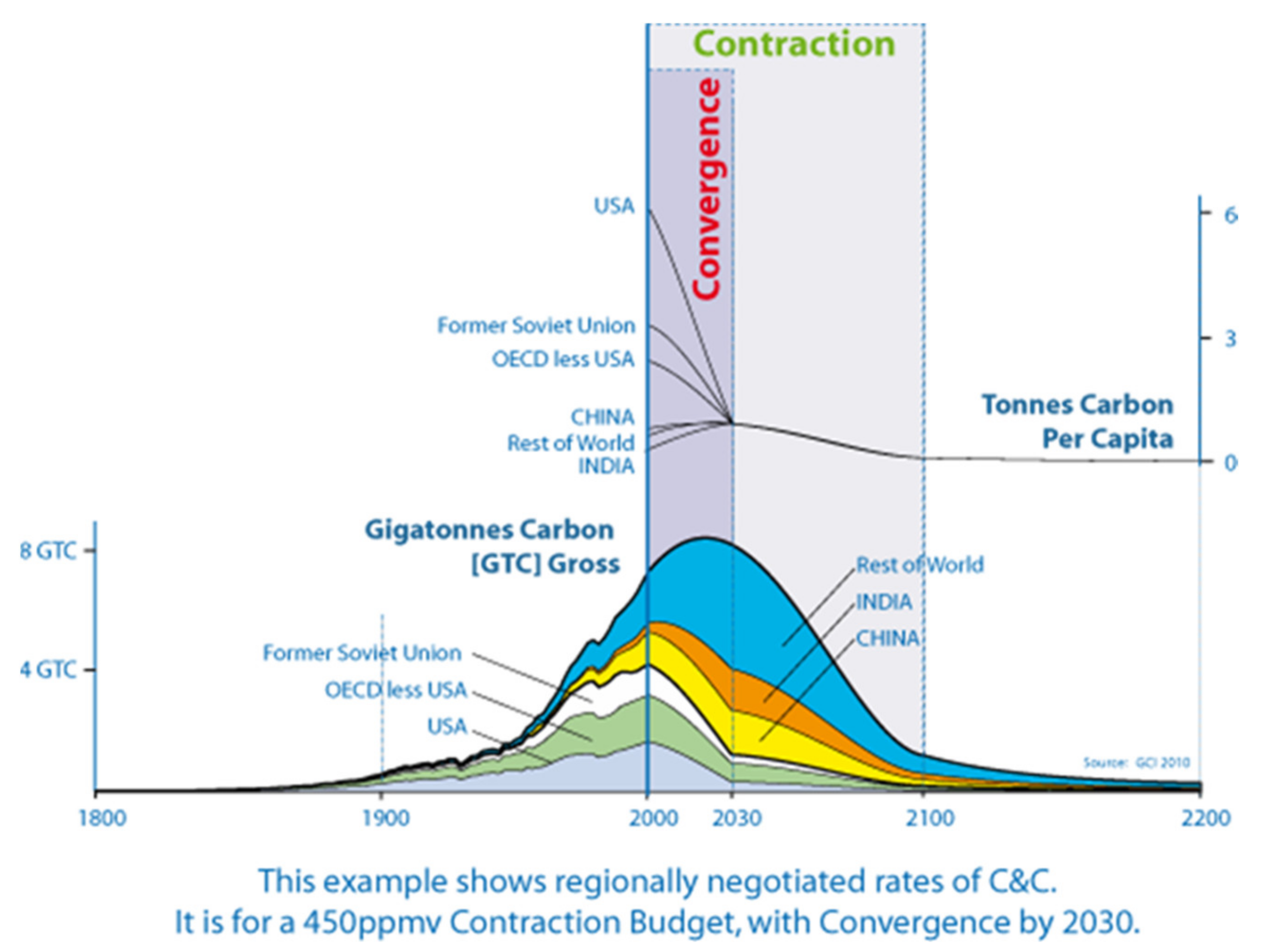
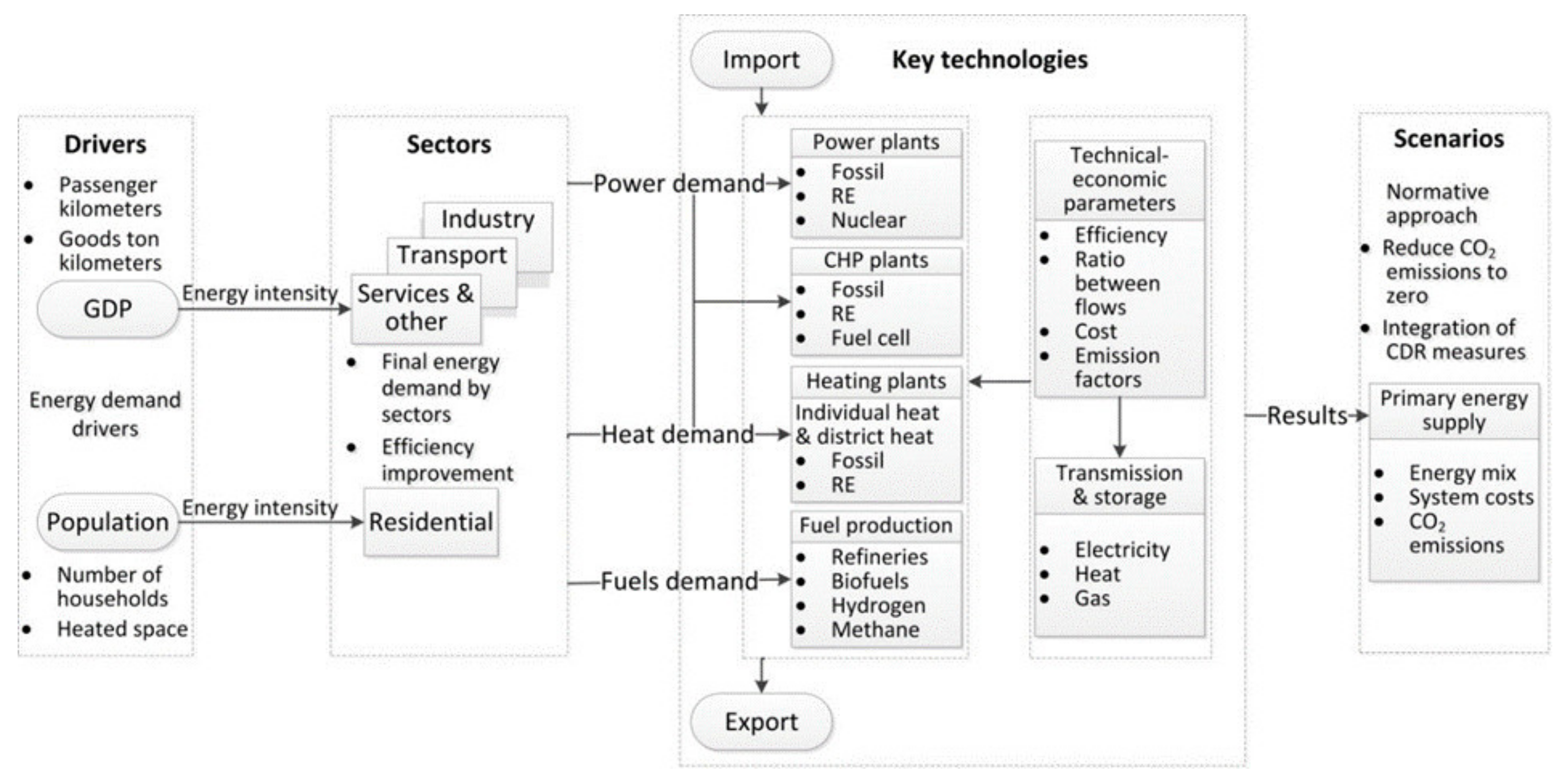

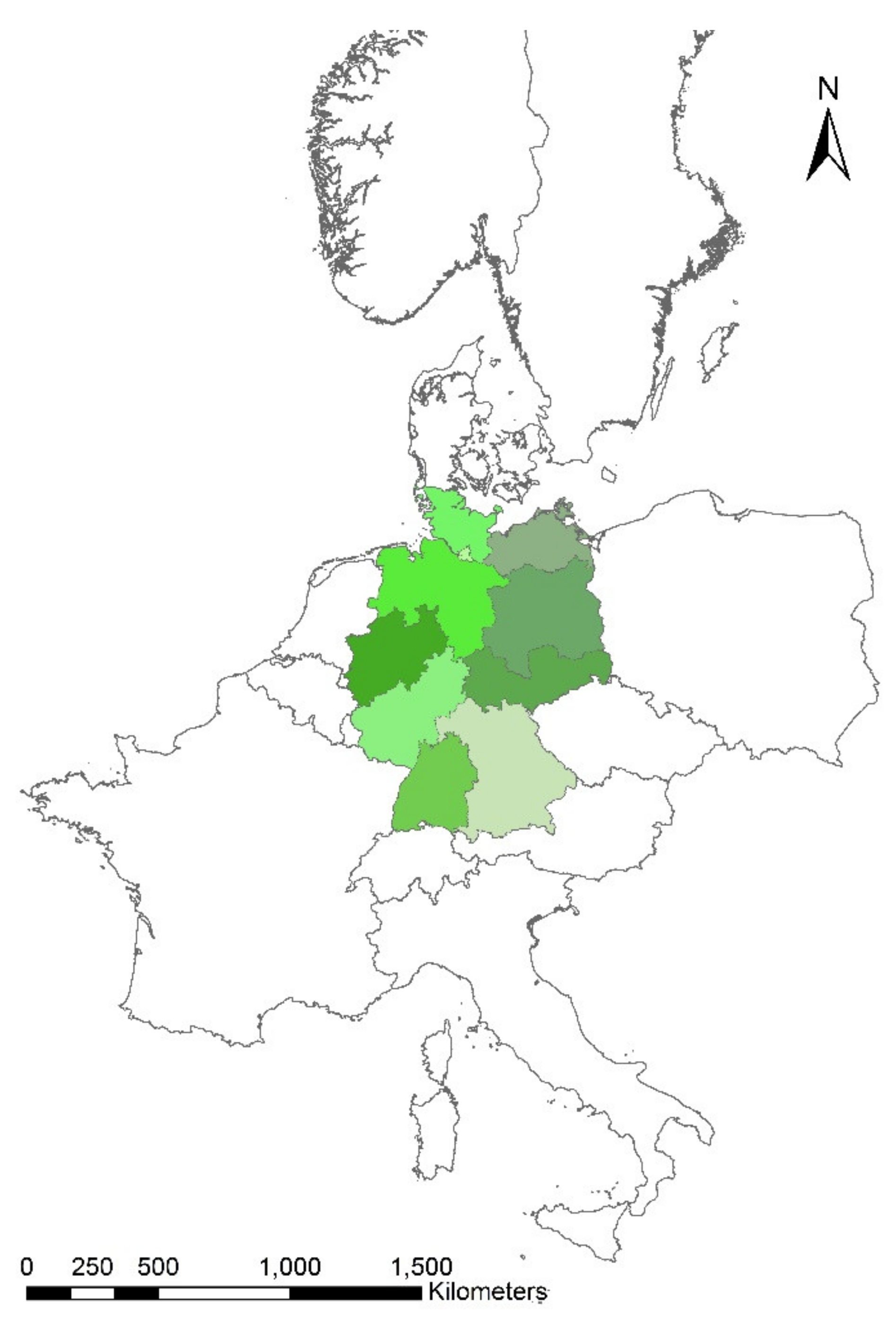

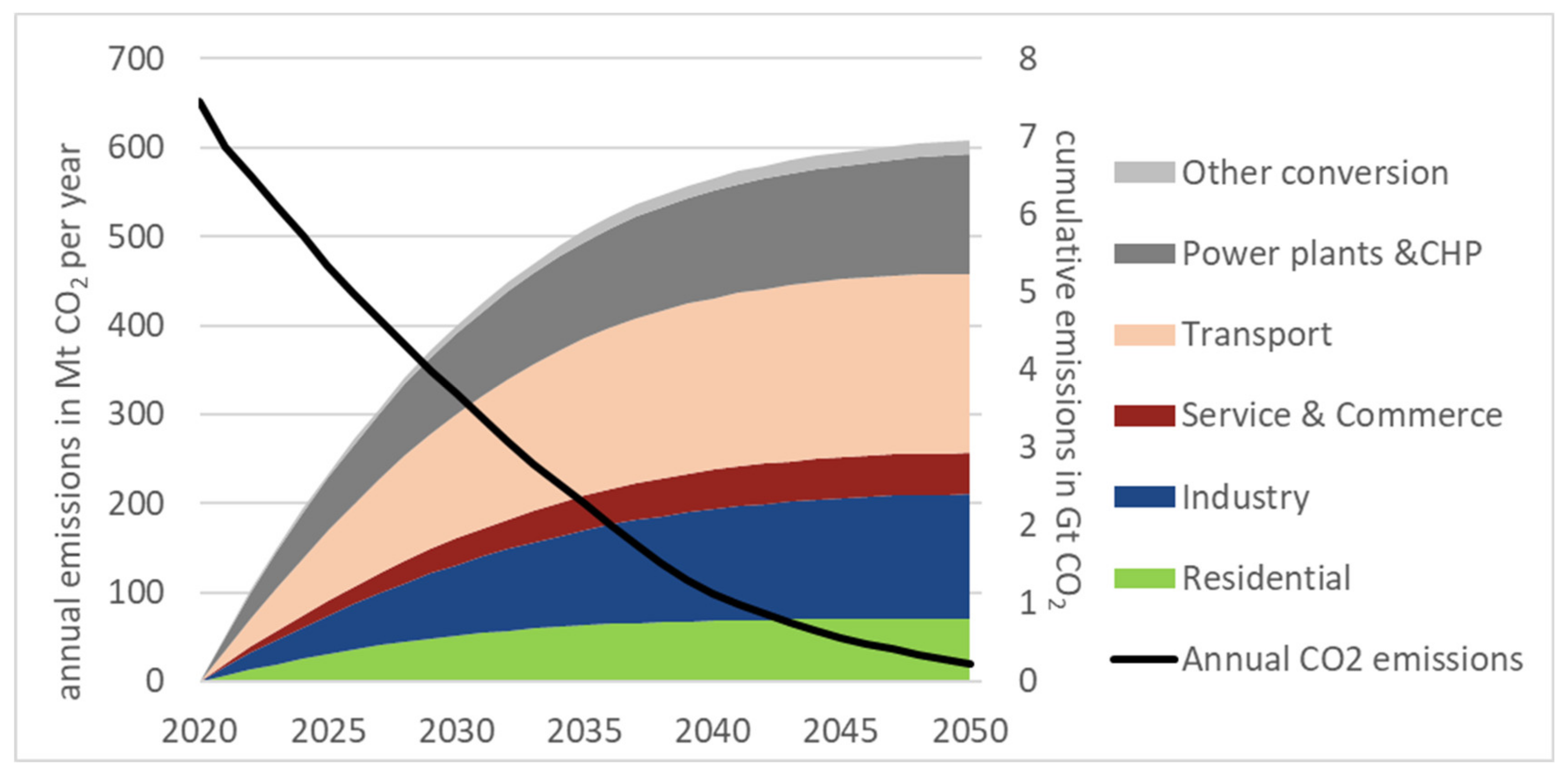






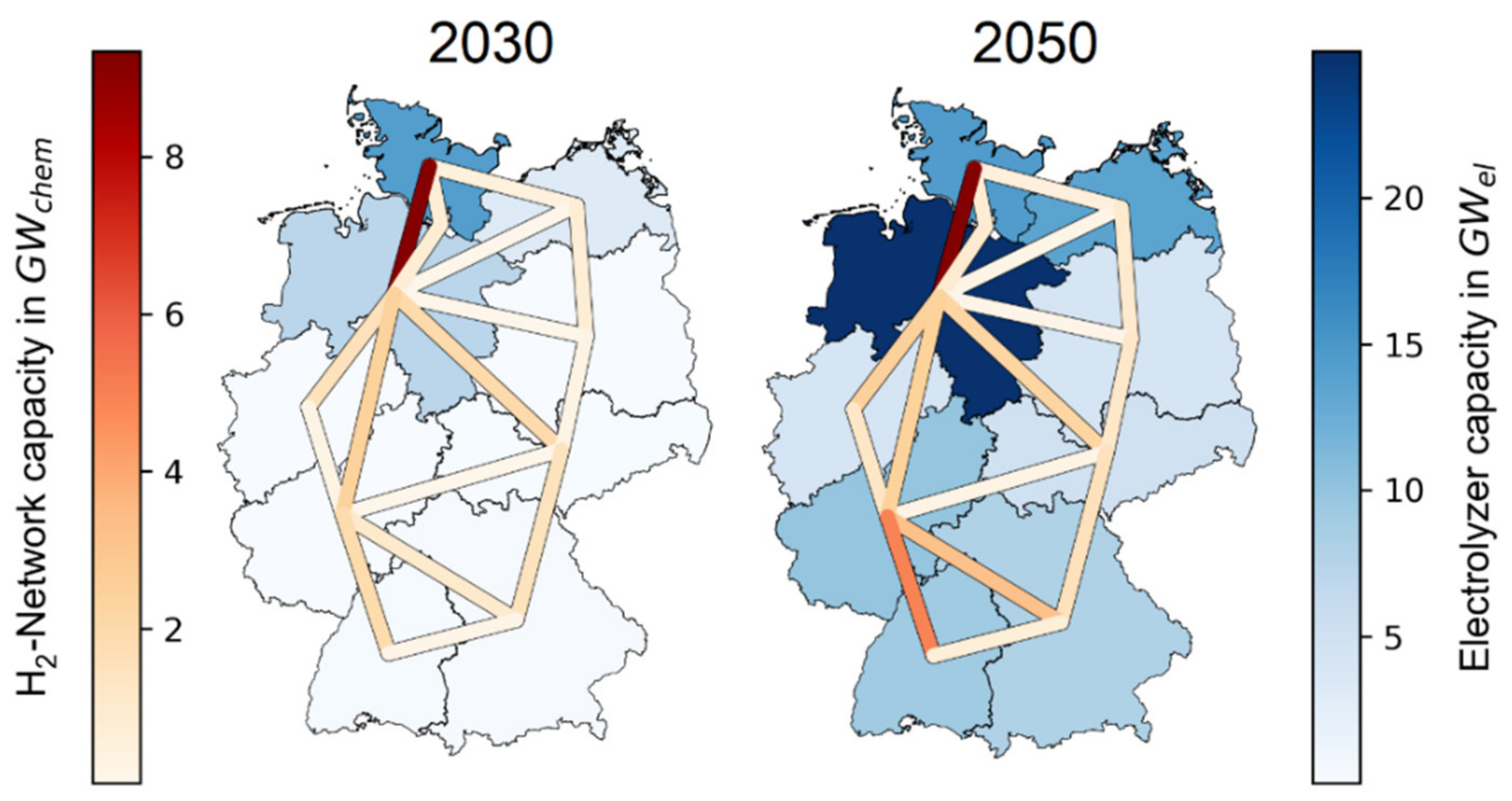
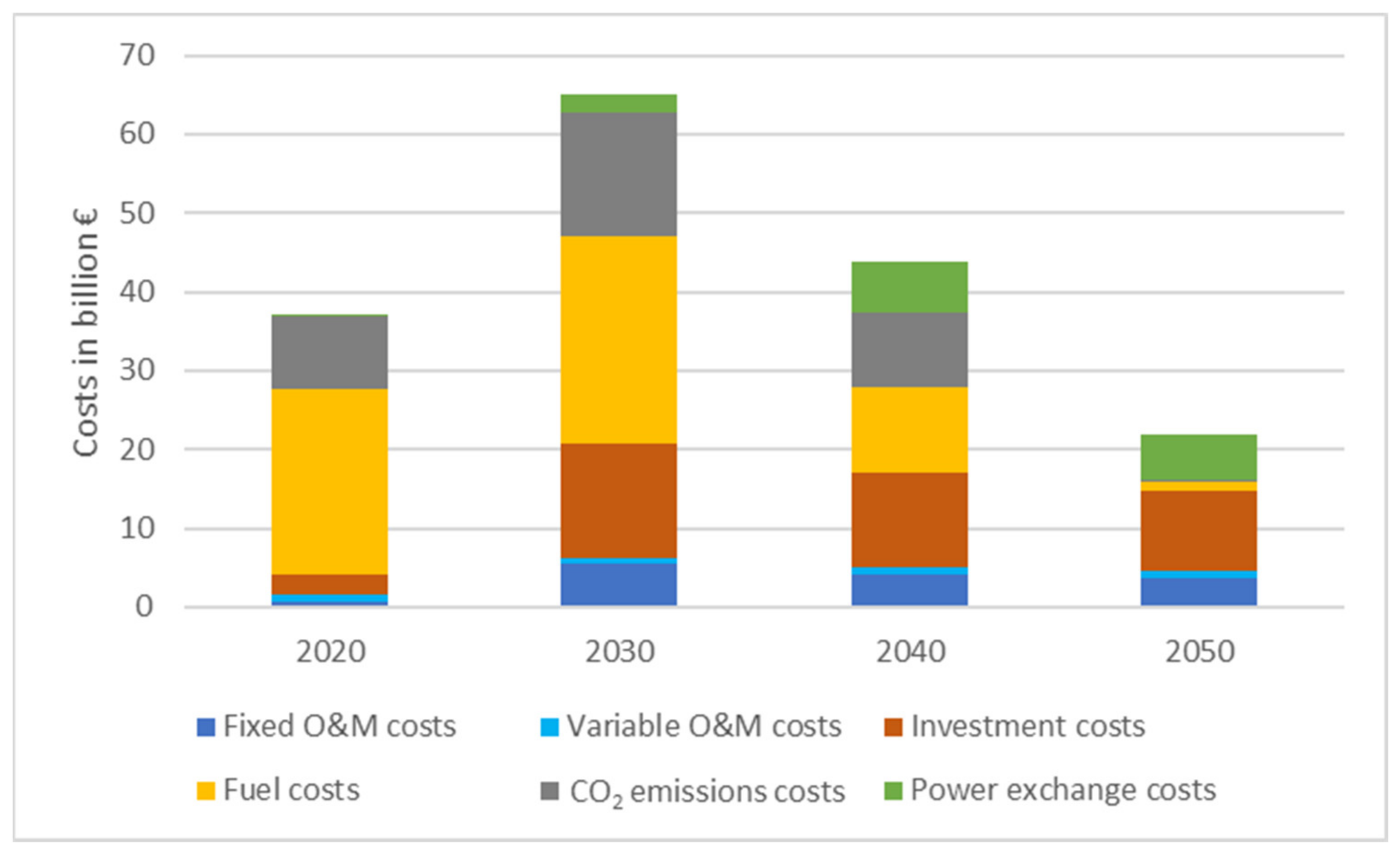
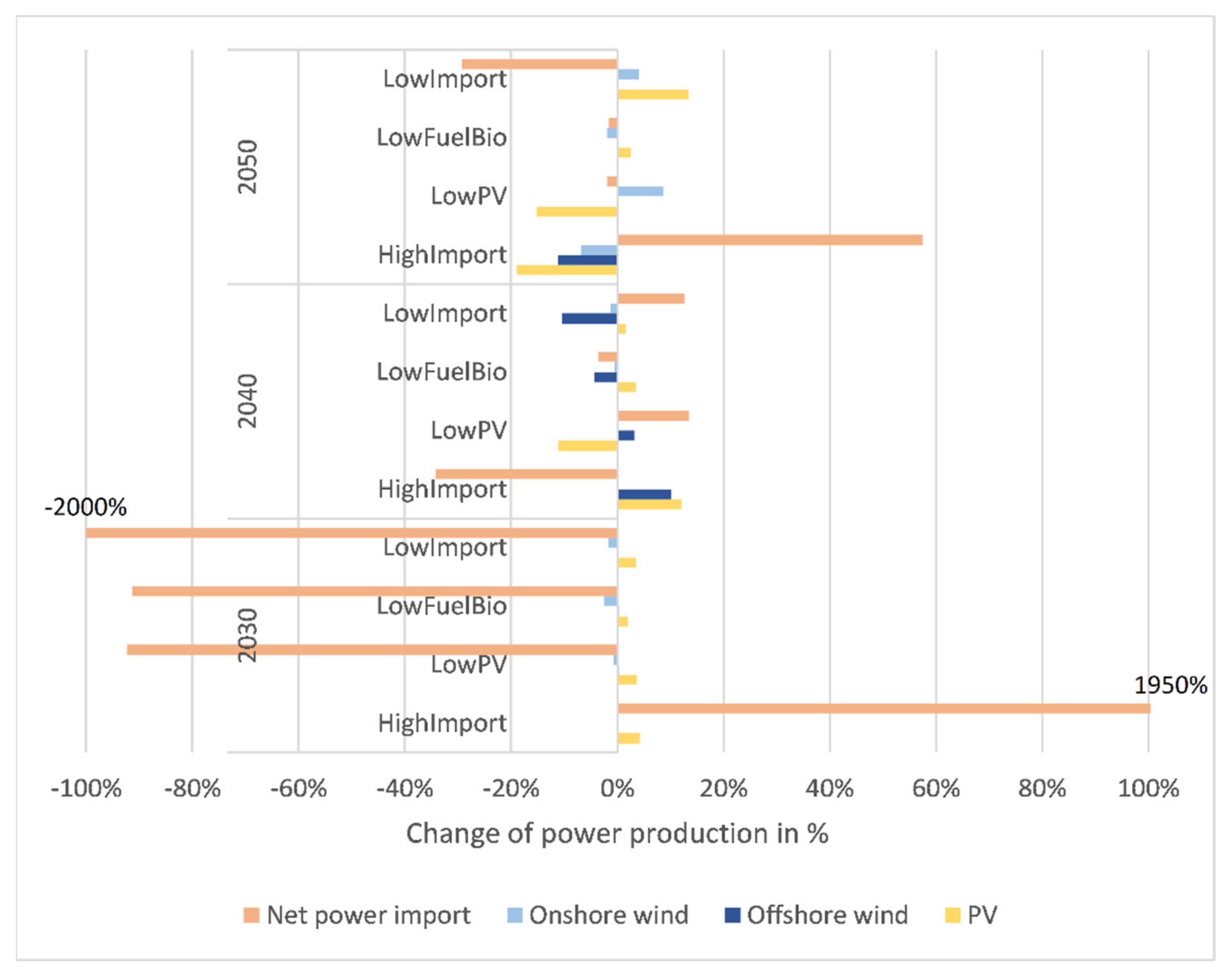
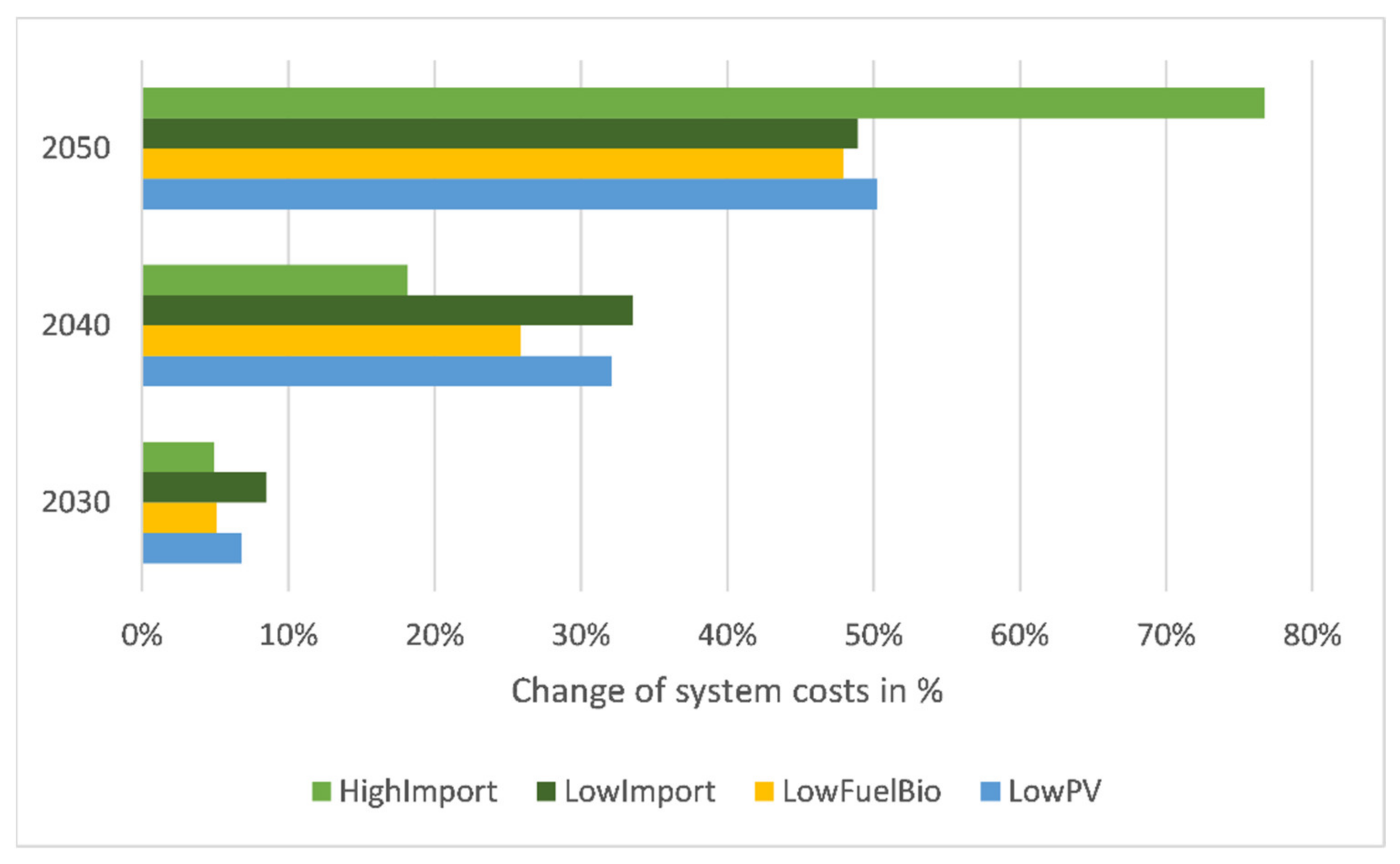
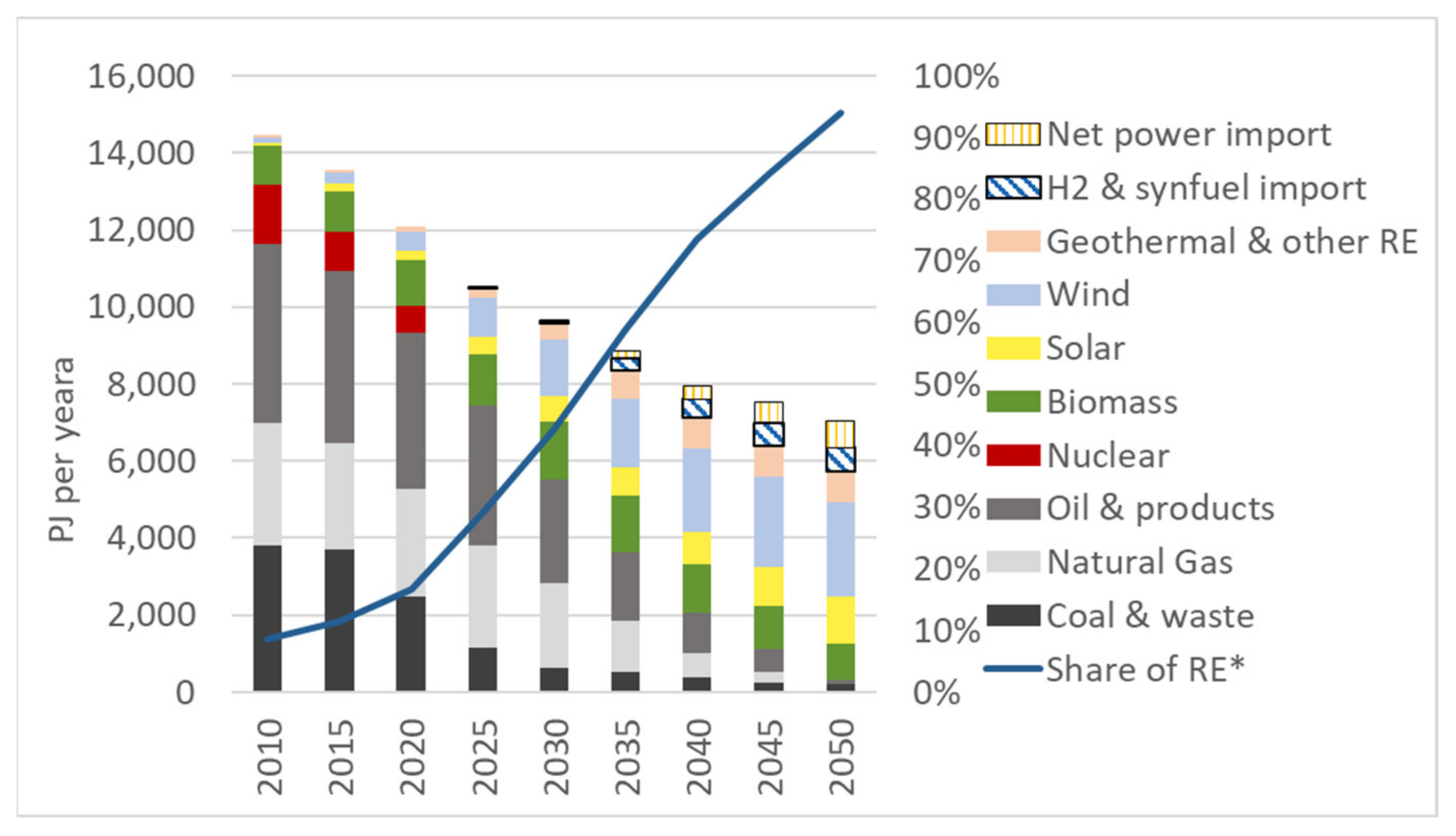
| Unit | 2020 | 2030 | 2040 | 2050 | |
|---|---|---|---|---|---|
| GDP | billion EUR2016 | 3326 | 3729 | 4088 | 4430 |
| Population | million capita | 83.5 | 82.9 | 81.3 | 79.0 |
| CO2 price high | EUR2016/t | 24 | 140 | 220 | 240 * |
| Fuel prices: | |||||
| Crude oil | EUR2016/GJ | 13.0 | 17.0 | 18.0 | 19.4 |
| Natural gas | EUR2016/GJ | 8.0 | 9.0 | 10.0 | 10.6 |
| Hard coal | EUR2016/GJ | 2.5 | 3.6 | 4.0 | 4.3 |
| Syncrude | EUR2016/GJ | 119 | 80 | 65 | 60 |
| Uranium | EUR2016/GJ | 0.6 | 0.7 | 0.9 | 1.0 |
| Lignite | EUR2016/GJ | 5.6 | 5.1 | 4.8 | 4.5 |
| Unit | 2020 | 2030 | 2040 | 2050 | |
|---|---|---|---|---|---|
| Biomass costs | |||||
| Waste wood and wood chips | EUR2016/GJ | 3.2 | 3.2 | 3.2 | 3.2 |
| Pellets, short rotation forestry | EUR2016/GJ | 13.9 | 14.8 | 15.8 | 16.7 |
| Landfill gas | EUR2016/GJ | 1.0 | 1.0 | 1.0 | 1.0 |
| Liquid biofuels | EUR2016/GJ | 21.6 | 28.3 | 35.0 | 41.7 |
| Raw biogas | EUR2016/GJ | 15.0 | 14.6 | 14.3 | 13.9 |
| Waste cost | EUR2016/GJ | 0 | 0 | 0 | 0 |
| Hydrogen cost * | EUR2016/GJ | 24.4 | 24.4 | 24.4 | 24.4 |
| Unit | Potential | Sources | |
|---|---|---|---|
| PV | GW | 566 | [26,35] |
| Wind | |||
| Onshore | GW | 217 | [58,59] |
| Offshore | GW | 72 | [26,35] |
| Biomass | |||
| Biogas | PJ/a | 950 | [55] |
| Solid Biomass | PJ/a | 340 | [55] |
| Energy crop area | mil ha | 2.7 | [56,57] |
| Energy Source | Residential Space Heat & Hot Water | Services: Space Heat & Hot Water | Industry: Space Heat & Hot Water | Industry: Process Heat |
|---|---|---|---|---|
| Power | 17% | 18% | 18% | 39% |
| Gas (Methane, H2) | 5% | 6% | 10% | 33% |
| District heat | 30% | 30% | 35% | 6% |
| Solar thermal | 10% | 10% | 8% | 5% |
| Biomass | 7% | 15% | 8% | 10% |
| Heat pumps and geothermal | 30% | 21% | 21% | 1% |
| Hard coal and waste | - | - | - | 4% |
| Oil products | - | - | - | 2% |
| Total | 100% | 100% | 100% | 100% |
| Scenario Names | Min. Domestic Power Generation Share | PV Potentials (Germany) | Fuel Price for Solid Biomass | Description |
|---|---|---|---|---|
| BS | 90% | 566 GW | High | High PV potentials |
| HighImport | 80% | 566 GW | High | Lower minimum domestic power generation share |
| LowPV | 90% | 283 GW | High | Half PV potentials |
| LowFuelBio | 90% | 566 GW | Low | Low fuel price scenario for solid biomass |
| LowImport | 95% | 566 GW | High | Higher minimum domestic power generation share |
Publisher’s Note: MDPI stays neutral with regard to jurisdictional claims in published maps and institutional affiliations. |
© 2022 by the authors. Licensee MDPI, Basel, Switzerland. This article is an open access article distributed under the terms and conditions of the Creative Commons Attribution (CC BY) license (https://creativecommons.org/licenses/by/4.0/).
Share and Cite
Simon, S.; Xiao, M.; Harpprecht, C.; Sasanpour, S.; Gardian, H.; Pregger, T. A Pathway for the German Energy Sector Compatible with a 1.5 °C Carbon Budget. Sustainability 2022, 14, 1025. https://doi.org/10.3390/su14021025
Simon S, Xiao M, Harpprecht C, Sasanpour S, Gardian H, Pregger T. A Pathway for the German Energy Sector Compatible with a 1.5 °C Carbon Budget. Sustainability. 2022; 14(2):1025. https://doi.org/10.3390/su14021025
Chicago/Turabian StyleSimon, Sonja, Mengzhu Xiao, Carina Harpprecht, Shima Sasanpour, Hedda Gardian, and Thomas Pregger. 2022. "A Pathway for the German Energy Sector Compatible with a 1.5 °C Carbon Budget" Sustainability 14, no. 2: 1025. https://doi.org/10.3390/su14021025
APA StyleSimon, S., Xiao, M., Harpprecht, C., Sasanpour, S., Gardian, H., & Pregger, T. (2022). A Pathway for the German Energy Sector Compatible with a 1.5 °C Carbon Budget. Sustainability, 14(2), 1025. https://doi.org/10.3390/su14021025







